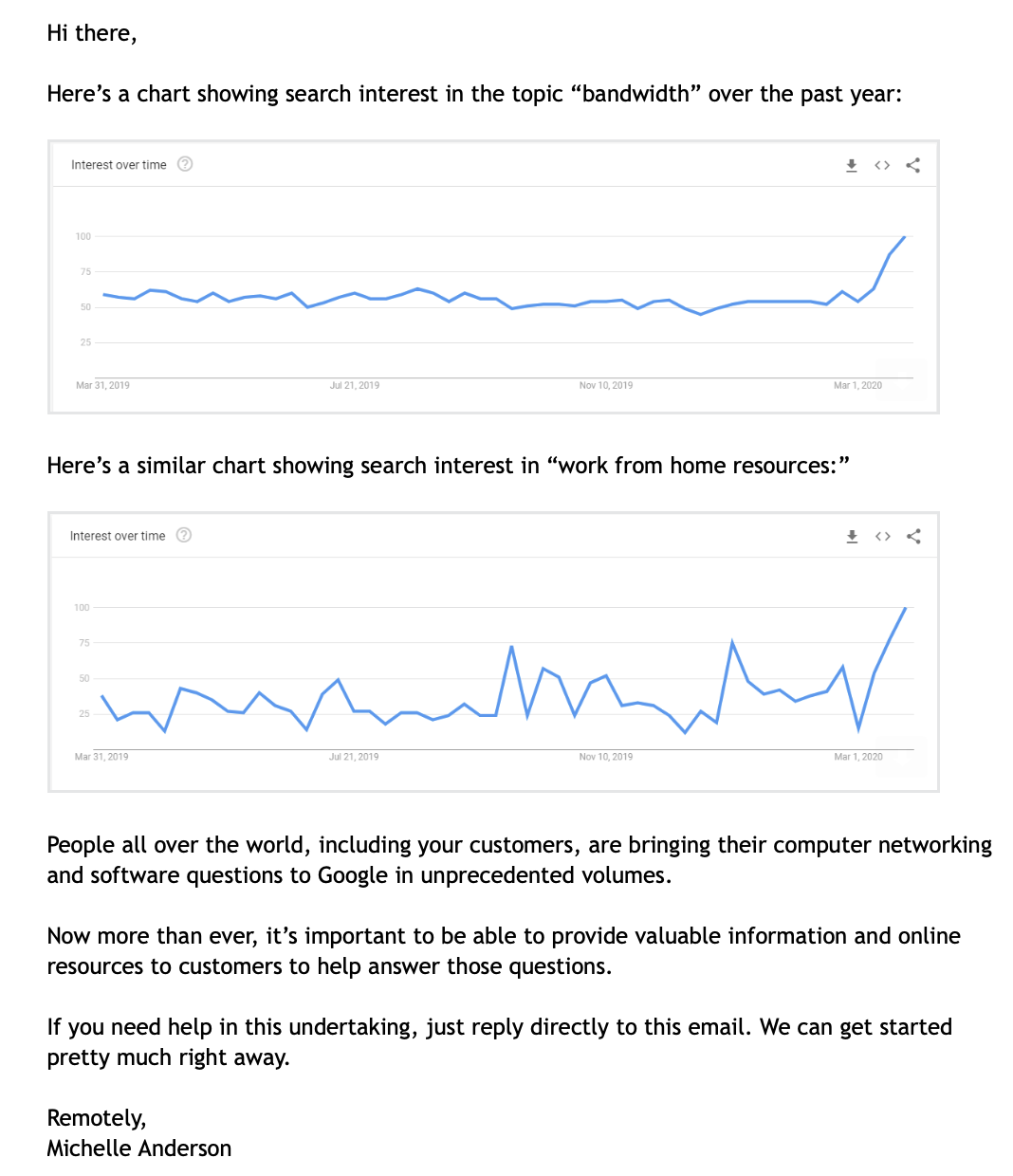As you trudge deeper into uncharted marketing territory, you probably have marketing questions, and we hopefully have the answers.
If you don’t see what you’re looking for here, check out our COVID-19 Resource Hub or contact us directly, and we’ll be glad to share what we know.
What should my messaging be around COVID-19?
That you’re here to help. Regardless of how your business is faring in these times, acknowledge what’s happening and provide resources that answer your customers’ and subscribers’ questions.
Here are a few key things to keep in mind:
- Make it clear to your customers at some point that health and safety are your top priorities, and assure them that you can maintain service levels.
- Don’t try to be a source of COVID-19 news for your target audience (unless you are actually qualified).
- Be constructive rather than harping on what’s bad in the world right now. You can express empathy and awareness while still being positive.
- Humorous distractions can be OK (and even welcome) from time to time, but don’t try to make light of COVID-19 or what people are going through.
- Always be mindful of the context of your messaging (e.g., don’t accidentally encourage gatherings, or create a false sense of urgency with phrases like “move fast” and “stock up”). The same applies to imagery.
- Do not misrepresent your products as essential or necessary and be mindful of any language that could be interpreted as such.
What content types should I be creating right now?
Whatever will be of the greatest value to your customers and your target audience. And that’s a judgment call you and your team have to make based on your understanding of who your current subscribers are and what they’re going through. We realize going off-script is a little scary, but this is new to everyone.
As for the content format, anything that is timely to this pandemic should be ungated. If it has a short shelf-life, you’ll want as many eyes on it as possible while it’s still relevant. Plus, any barriers to entry will run counter to the first rule of crisis marketing: be helpful.
Based on a recent survey we conducted, marketers prefer to use these channels for COVID-19 messaging:
- Email.
- Social media.
- Blog posts.
- Interactive content.
You can read more about what these channels have to offer, here.
What should I be doing right now to plan for post-coronavirus marketing?
If you have time, we’d recommend stocking up on lead generation and lead nurturing content. We’re talking gated assets (eBooks, white papers) that your audience has an appetite for in normal times.
Even if it lacks immediate value, there will eventually be a rebound, and anything you can do now to get ahead of the rat race will put you in a better position to succeed later.
Now’s also a good time to think about post-coronavirus messaging. Align business priorities based on how your company has been affected, and brainstorm future marketing strategies to either win back the customers you’ve lost or retain the ones you’ve gained.
What changes should I make to my SEO strategy?
There isn’t much reliable keyword data available right now. People are asking entirely new sets of questions in the context of this crisis and most keyword research tools have lagging data on trends and volume. Furthermore, we’re seeing rapidly shifting SERP landscapes for COVID-related content. It’s a new space, so we are going to see crazy fluctuations in SERPs.
This makes it hard to be prescriptive.
That said, there are a few things you can and should be doing. For starters, keep an eye on your search visibility across different segments of your site. Use Search Console to see trends in your commercial intent keywords and landing pages. Evaluate trends/anomalies in impressions, clicks, average position and click-through rate. Do the same for your blog segments. You can also use tools like SEMrush, Ahrefs and Moz to find fluctuations in total keyword rankings and targeted keyword rankings. Always keep an eye out for anomalous changes, positive and negative.
Also, you can try to use Google Trends to get a very rough gauge of what people are searching for right now. The data is imprecise, and it’s based on samples of what people are searching for, but it still has some value.
For now, though, your best compass is your gut. Ask yourself what your audience would want to know – or what they might find helpful – and use that as your topic guide.
Should I drop my ad and PPC campaigns?
Not necessarily. Some commodities such as software, e-commerce, online gaming, streaming services, etc. are in high demand right now. It might make sense for companies in these industries to run ads, particularly if those ads are promoting free membership or sign up during this time.
But if you’ve seen business slow down, it probably has more to do with what people are willing to spend than it does exposure to your brand. An ad probably won’t do much for your audience if they’re struggling, but helpful content might.
How should I approach sales emails?
Cautiously.
Do not send sales emails to industries that are hurting (transportation, hospitality, brick-and-mortar retail).
Do consider sending out sales emails to industries that are actually seeing an increase in business (software and computer networking, telecom, streaming services). However, do not emphasize the fact that these companies are benefiting from the situation. Also, avoid pushing any one single product. Focus on ways you might be helpful right now. For instance, you might consider mentioning that they are really busy responding to this crisis and that you would like to talk about how you might be able to assist with XYZ.
This is an example of a sales email we created that had strong engagement, using the subject line “Some data you might find interesting”:

Trade shows are my biggest source of leads. What do I do now?
We created an entire blog post about this specific topic. Read it here.
Should I be doing anything differently on social media?
Probably. My colleague Jess Wells created a guide on this subject, which you can find here.
Additional resources
- 10 content marketing ideas for the coronavirus lockdown.
- How to communicate with your clients right now.
- How to be ‘helpful first’ in a rapidly changing marketing environment.
- How to do ethical marketing during the coronavirus quarantine.
- How to work from home (A guide for beginners and seasoned remote workers alike).





